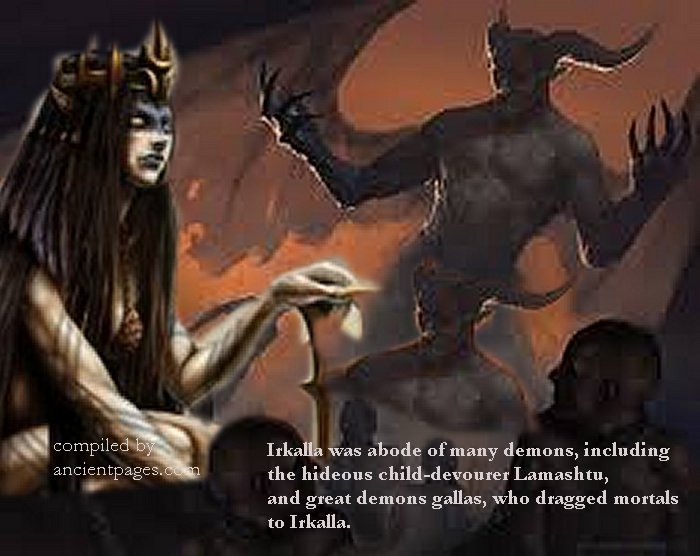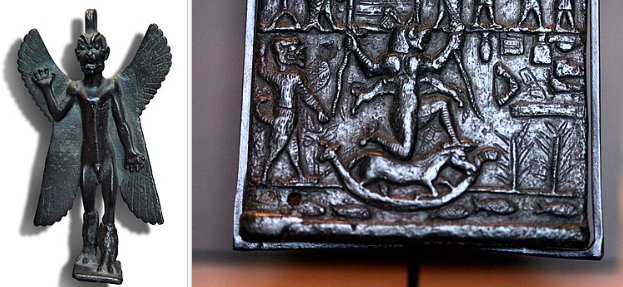Irkalla – Underworld With No Return Ruled By Ereshkigal, Granddaughter Of Enlil And Sister Of Inanna
A. Sutherland - AncientPages.com - In Babylonian mythology, Irkalla was the underworld from which there was no return. The realm of the dead or the lower world was also called Arali, Kur, Kigal, and Gizal.
There were two traditions explaining how humans entered the netherworld. According to one, the road to the underworld passed through the steppe land swarming with demons, across the Khabur River, and then through seven heavily guarded gates.
Another version described a road to the netherworld crossed by boat down one of the rivers of the upper earth. Then, across the apsu (the sweet waters under the earth) to Irkalla, the lower earth.
At first, the only ruler of Irkalla was Ereshkigal ("Queen of the Great Below"), a granddaughter of Enlil and older sister of Inanna (Ishtar). Later she ruled the netherworld with her husband, Nergal, the king of death who brings disease, plague, and all misfortunes caused by heat. Ereshkigal's judgment and laws were always indisputable.
Irkalla was the abode of many demons, including the hideous child-devourer Lamashtu, the fearsome wind demon and protector god Pazuzu, and great demons Gallas (or Gallu) busy with dragging mortals to Irkalla.
Location Of Irkalla
Based on various texts, it can be assumed that the Babylonians located the entrance to the underground world, where the sunset was in the western desert.
Left: Bronze statuette of Pazuzu (c. 800 – c. 700 BC). Credit: Public Domain - Right: Close-up of Lamashtu from a lead protection plaque dating to the Neo-Assyrian Period (911 – 609 BC). Credit: Public Domain
The Babylonian sun god, Shamash, descended to these regions in the evening. Then, he appeared again from the mountains in the east in the morning. The netherworld was situated even lower than the Abzu, the fresh-water ocean beneath the earth.
Grave Of The Deceased – The Entrance To Irkalla
In Babylonian writings, the grave was the entrance to the underground world for the man who was buried in it. The Sumerian beliefs inspired the Babylonian myths, which were later repeated and further developed.
All people, regardless of their positions, age or morals, descended after death to Irkalla. It was the same afterlife for all souls.
The only food or drink was dry dust, but family members of the deceased would pour libations for them to drink.
In "The Ark Before Noah: Decoding the Story of the Flood," Irving Finkel cites a description of Irkalla as a dreary place: The netherworld was described as a dreary place:
To the gloomy house, seat of the netherworld,
To the house which none leaves who enters,
To the road whose journey has no return,
To the house whose entrants are bereft of light,
Where dust is their sustenance and clay their food.
They see no light but dwell in darkness,
They are clothed like birds in wings for garments,
And dust has gathered on the door and bolt..."
(The Descent of Ishtar to the Netherworld" 4-11)
Not all views of the afterlife were the same among ancient beliefs of other cultures.
Unlike other views of the afterlife, in the Sumerian underworld, there was no final judgment of the deceased. The dead were neither punished nor rewarded for their deeds in life. Their burial conditions determined a person's quality of existence in the underworld.
Ancient Sumerian cylinder seal impression showing the god Dumuzid being tortured in the underworld by galla demons. Credit: Public Domain
As the dark underground realm, cut off from life and God, Irkalla was the ultimate destination for all who died. The domain is similar to Sheol (She'ol) of the Hebrew Bible, where all the dead - righteous and the unrighteous – must meet. It happens regardless of the moral choices and deeds made in life.
But at the same time, it is very different from more hopeful visions of the afterlife that later appeared in Platonic philosophy, Judaism, and Christianity, unlike visions of the ancient Egyptian afterlife.
After crossing the Hubur river, the deceased (naked or clothed in feathers like birds) stood in front of the seven city walls and had to pass through seven gates guarded by the guards. The ruler would pronounce them dead, and their names would be recorded on a tablet by a scribe.
In Irkalla, the deceased had to face Ereshkigal as they were born – naked, without garments and personal ornaments.
Written by – A. Sutherland AncientPages.com Senior Staff Writer
Updated on October 5, 2022
Copyright © AncientPages.com All rights reserved. This material may not be published, broadcast, rewritten or redistributed in whole or part without the express written permission of AncientPages.com
Expand for referencesReferences:
Black J., Green A. Gods, Demons and Symbols of Ancient Mesopotamia
Finkel I. The Ark Before Noah: Decoding the Story of the Flood"
More From Ancient Pages
-
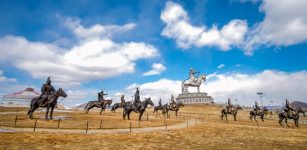 Mongol Empire: Rise And Fall Of One The World’s Largest And Fearsome Empires
Featured Stories | Mar 26, 2021
Mongol Empire: Rise And Fall Of One The World’s Largest And Fearsome Empires
Featured Stories | Mar 26, 2021 -
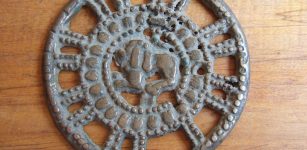 “Thogcha” – Thousand-Year-Old Tibetan Amulets And The Bon Culture
Ancient Technology | Dec 11, 2021
“Thogcha” – Thousand-Year-Old Tibetan Amulets And The Bon Culture
Ancient Technology | Dec 11, 2021 -
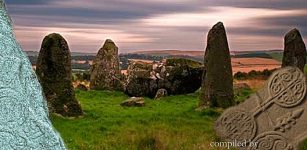 Cruithne: Legendary King, His Seven Sons And The First Celtic Tribe That Inhabited British Isles
Celtic Mythology | May 27, 2023
Cruithne: Legendary King, His Seven Sons And The First Celtic Tribe That Inhabited British Isles
Celtic Mythology | May 27, 2023 -
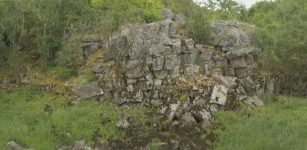 Unique Bronze Age Fortress Discovered In Galway, Ireland
Archaeology | Jun 25, 2022
Unique Bronze Age Fortress Discovered In Galway, Ireland
Archaeology | Jun 25, 2022 -
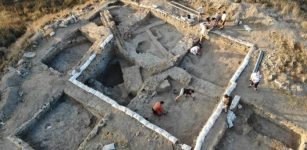 Huge Defensive Wall Excavated At Tel Erani, Israel Is More Than 5,300 Years Old
Archaeology | Sep 12, 2019
Huge Defensive Wall Excavated At Tel Erani, Israel Is More Than 5,300 Years Old
Archaeology | Sep 12, 2019 -
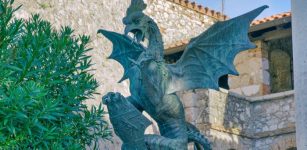 Legendary Basilisk With Deadly Petrifying Stare – King Of The Serpents
Featured Stories | Dec 27, 2021
Legendary Basilisk With Deadly Petrifying Stare – King Of The Serpents
Featured Stories | Dec 27, 2021 -
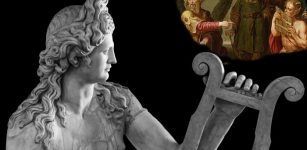 Apollo Punished Rivals For Their Extraordinary Musical Skills
Featured Stories | Apr 19, 2022
Apollo Punished Rivals For Their Extraordinary Musical Skills
Featured Stories | Apr 19, 2022 -
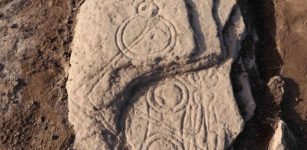 Rare Pictish Symbol Stone Found Near The Battle Of Nechtansmere Site
Archaeology | Mar 7, 2022
Rare Pictish Symbol Stone Found Near The Battle Of Nechtansmere Site
Archaeology | Mar 7, 2022 -
 Why Is Roulette Called The Devil’s Game?
Ancient History Facts | Apr 3, 2018
Why Is Roulette Called The Devil’s Game?
Ancient History Facts | Apr 3, 2018 -
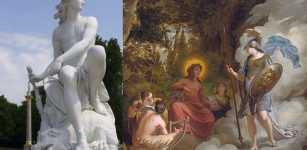 Apollo – Loved And Feared Greek God Of Divination And Prophecy Who Was Also Seer Of Zeus
Featured Stories | Feb 6, 2019
Apollo – Loved And Feared Greek God Of Divination And Prophecy Who Was Also Seer Of Zeus
Featured Stories | Feb 6, 2019 -
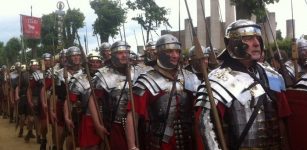 The Word Salary Has Roots In Ancient Rome And History Of Salt
Ancient History Facts | Jun 29, 2016
The Word Salary Has Roots In Ancient Rome And History Of Salt
Ancient History Facts | Jun 29, 2016 -
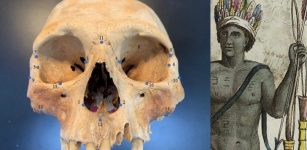 3D Facial Landmarks Reveal Columbus’ Cannibal Claims Were No Myths But True Accounts
Archaeology | Jan 15, 2020
3D Facial Landmarks Reveal Columbus’ Cannibal Claims Were No Myths But True Accounts
Archaeology | Jan 15, 2020 -
 7,000-Year-Old Kilns From Ceramics Workshop Unearthed In Northeast Bulgaria
Archaeology | Nov 20, 2020
7,000-Year-Old Kilns From Ceramics Workshop Unearthed In Northeast Bulgaria
Archaeology | Nov 20, 2020 -
 The Untold Story Of Mexico’s Ancient Giant Indians – Cunning Plan And The Evil Nation – Part 2
Featured Stories | Sep 23, 2019
The Untold Story Of Mexico’s Ancient Giant Indians – Cunning Plan And The Evil Nation – Part 2
Featured Stories | Sep 23, 2019 -
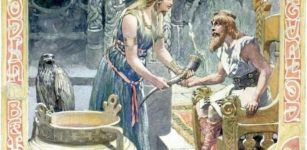 Death Of Kvasir And How Famous Mead Of Poetry Was Created, Stolen And Finally Recovered By Odin
Featured Stories | Apr 14, 2018
Death Of Kvasir And How Famous Mead Of Poetry Was Created, Stolen And Finally Recovered By Odin
Featured Stories | Apr 14, 2018 -
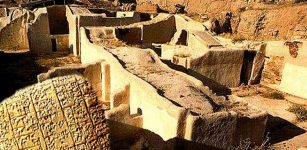 Controversial Discovery : 15,000 Ancient Ebla Tablets Prove Old Testament To Be Accurate
Archaeology | Oct 5, 2015
Controversial Discovery : 15,000 Ancient Ebla Tablets Prove Old Testament To Be Accurate
Archaeology | Oct 5, 2015 -
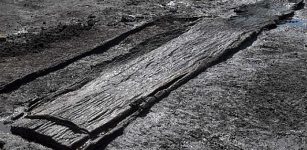 Bronze Age ‘Washingborough Boat’ Will Reveal Boat Building Techniques Of Ancient People
Archaeology | May 11, 2017
Bronze Age ‘Washingborough Boat’ Will Reveal Boat Building Techniques Of Ancient People
Archaeology | May 11, 2017 -
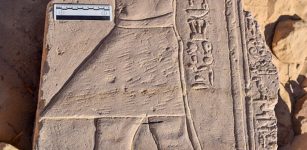 2nd Century Roman Temple Unearthed In Aswan, Egypt
Archaeology | Feb 23, 2018
2nd Century Roman Temple Unearthed In Aswan, Egypt
Archaeology | Feb 23, 2018 -
 This Lunar Year Will Be The Year Of The Rabbit Or The Year Of The Cat, Depending On Where You Live
Ancient Traditions And Customs | Jan 23, 2023
This Lunar Year Will Be The Year Of The Rabbit Or The Year Of The Cat, Depending On Where You Live
Ancient Traditions And Customs | Jan 23, 2023 -
 DNA From 35,000-Year-Old Romanian Skull Reveals Flaws In The Theory Of Evolution
Archaeology | May 25, 2021
DNA From 35,000-Year-Old Romanian Skull Reveals Flaws In The Theory Of Evolution
Archaeology | May 25, 2021

